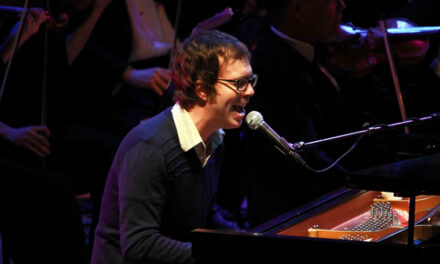As part of the East Carolina University School of Music Trumpet Boot Camp, Thomas Huener, baroque trumpet, Jon Ward Shaw, soprano, and John B. O’Brien, organ, presented “Amphion’s Echo – 17th & 18th century music for baroque trumpet, voice, and continuo” in the A. J. Fletcher Music Center.
A crowd of perhaps 100 brought good enthusiasm to this strange little concert. In my experience there is a glib perfection in Broadway-type pit bands. Anyone who has ever been present at the controlled insanity of a live Prairie Home Companion performance has seen the inimitable Rich Dworsky, seemingly in a world of his own and the clock ticking down. Then he flashes a big smile and in the most relaxed way enters perfectly and plays like a young god. Such is the keyboard mastery of John O’Brien; he seems totally relaxed, sounds perfectly in control, and brings such freshness to his playing that if one didn’t know better one would be sure he had never seen the music before. Jon Ward Shaw, soprano, brings the same assurance and confidence to her art, combining great singing with lovely gestures and a warm smile. Trumpet solo was provided by Thomas Huener, playing by turns the usual single-fold baroque trumpet and a curly-fries jagdtrompette, typical of the instrument seen in the hands of Bach’s trumpeter Gottfried Reiche in the Hausmann portrait. Both of Huener’s instruments are modern reproductions of authentic period instruments.
The performance began with George Frideric Handel’s “Eternal Source of Divine Light,” an aria not about God, as you might suppose, but for the birthday of Queen Anne in 1713 or 1714. The work is very demanding, at least in the trumpet part, perhaps too demanding to open with. Shaw and O’Brien were well up to the task, with Huener on conventional “long” baroque trumpet.
In the first of many verbal interludes, Huener, the only spokesman for the group, offered spoken program notes. Somehow it seems unlikely that Handel’s performances included verbal teaching, but concerts in the country these days seem to have stand-up chat as a necessity. Handel himself was consistent in the spelling of his names, first and last, once he settled in England. That Huener is a musicologist may explain the German spelling of the composer’s name on the program, right down to an umlaut. Huener suggested that the long form of the trumpet was used when a trumpet was called for on stage in an opera and that the coiled trumpet was used in the orchestra pit. The jagdtrompette used in this performance had a darker quality than the long.
Next on the program was “Let The Bright Seraphim” from Handel’s Samson. (The program gives Sampson; that would be a county in North Carolina, the same state whose newspaper typesetters used to list the Tobacco and fugue in d minor.) Shaw was in full good form, musically superb, with gestures and smiles to match. O’Brien provided his customary rhythmic drive.
Huener switched to the jagdtrompette for three arias by Alessandro Scarlatti, “Si suoni la tromba,” “Mio Tesoro, per te moro,” and “Con voce festiva,” and for Alessandro Melani’s cantata “All’arme, pensieri.” Huener’s intonation, all over the map from the beginning, was no better using the jagdtrompette. In addition to the natural trumpet having a scale more like the mean-tone scale than the equal-temperament scale familiar to modern musicians, Huener’s pitch was, far more often than not, flat. O’Brien and Shaw seemed to have a different sense of tempo from Huener; whenever he entered, slowing down seemed necessary. At the end of his phrase, O’Brien and Shaw would return to what seemed a much more convincing tempo.
Some of Huener’s best playing was in the Melani “Se un petto costante si fa.” The Melani was a fine vehicle to showcase Shaw’s rich, warm soprano, underlaid by O’Brien’s precise and musical accompaniment. Shaw’s voice is a treat in all ranges; there was one very low place in this performance where her voice positively chuckled with good humor as she sang.
Huener’s overall performance was disappointing for suggesting, in a teaching situation amid a throng of aspiring young performers, that this is an acceptable performance standard, a suggestion doubling disappointing beside O’Brien and Shaw. The baroque trumpet is a perfectly playable and reasonable instrument; performances like this give authentic performance practice an undeservedly bad name.











